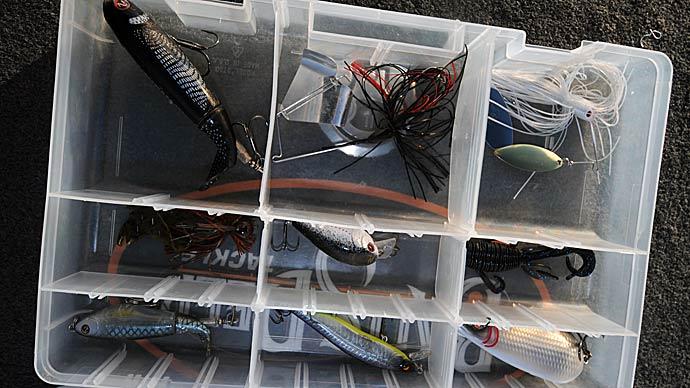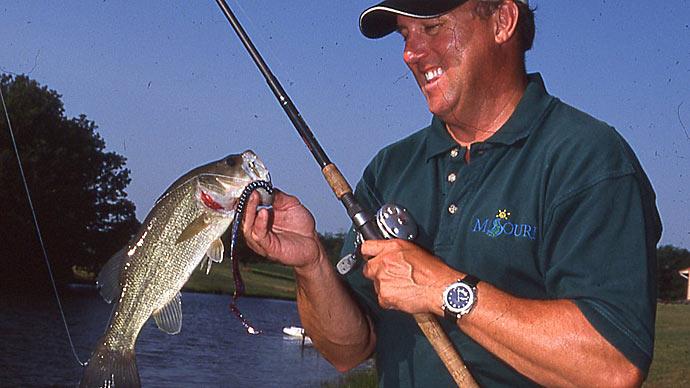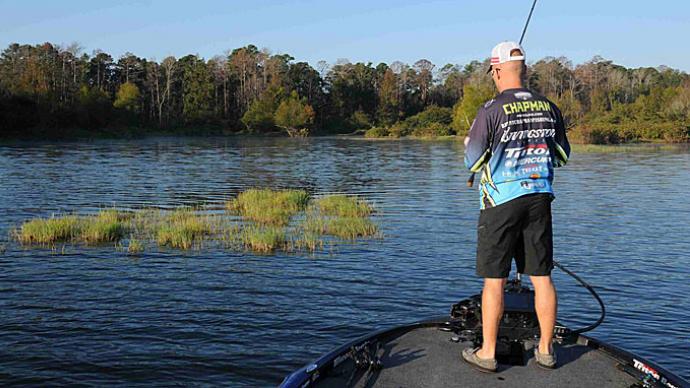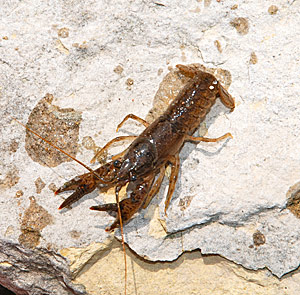
If you picked a crayfish imitation every time you fished for smallmouth bass, you could do much worse. The fact is you’d be hedging your bet. In many locales, for a significant portion of the year, as much as 60 to 70% of a smallmouth’s diet is crayfish. Experts will tell you that crayfish were made to order for smallmouths. Behavioral naturalists theorize that a smallmouth's powerful jaws and mouth structure evolved to snatch defensive crawdads from their rock-strewn hideouts. In other words, smallies are crayfish-eating machines.
One reason crayfish and smallmouth bass have such a common bond is availability. There are hundreds of different species of crawfish worldwide, and a good portion of them can be found in the USA. Most states have at least a half dozen or more crayfish species, and they vary significantly in size and coloration, but they all have in common: they are potential smallmouth fodder.
Some species now found in the waters of the northern tier of states in prime smallmouth country are not native. The rusty crayfish, which found their way into lakes and reservoirs via angler’s bait buckets and migration, compete with and displace native crayfish species. Still, to a hungry bronzeback, it doesn’t make much difference. Do you want a rib eye or a NY strip? The bait industry is mainly responsible for introducing non-native crayfish species that have spread exponentially and, in some cases, have severely altered habitats.
What anglers need to discover is which species are most common in the waters they fish, figure out the habitat they prefer, and get an idea of the average size that bass are keying in on and their color. Generally, darker-colored lures that imitate something scooting along the bottom will get eaten. Colors range from dark green or brown to red or even bluish colors. Anglers must discover which colors predominate in the waters they fish to match the hatch.
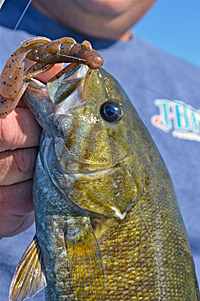
“How much smallmouths key in on crayfish depends on the body of water,” suggested smallmouth aficionado, Joe Balog. “Crayfish are most active when the water is warm, but that’s all relative. Crayfish in Florida might be very active when the water is in the 70s, but a cold front that drops water temperatures into the low 60s will shut them down. Conversely, in the northern tier of states, crayfish will be active in much colder water. When the water temperature reaches 50 degrees, crayfish start to get active, but I’ve witnessed active crayfish in frigid water, especially in late winter. It’s not uncommon to see crayfish crawling along the bottom when I’ve been ice fishing. I’ve observed hundreds of live crayfish blown up on shore in late fall after a big blow when the water wasn’t much above freezing, so they must have been active to be subjected to the waves. Crayfish are still very active when the water is in the 38 to 44-degree range in northern climes. I regularly catch smallmouth through the ice. You must believe that crayfish are available to bass all year long.”
Crayfish seem to be the most preferred prey during warm weather, and their consumption decreases as the year go on in favor of baitfish, but no self-respecting smallmouth will turn down a crawdad. The preference is somewhat confusing, considering crayfish don’t provide nearly the protein that a baitfish does. More than half of a crawdad’s live weight is non-digestible claws and shell or exoskeleton. Still, crayfish can make up as much as 80 percent of a smallmouth's diet early in the season. Given a choice, bass prefer smaller, softer crayfish versus larger, intimidating adults. The lack of other forage may dictate their preference early in the year. As the season progresses, YOY perch, bluegills, gobies, and minnows become larger and more readily available and a larger portion of their diet.
One absolute is that if you’re trying to imitate crayfish, your lure had better be on or close to the bottom. “Crayfish are bottom creatures,” stated Joe Balog. “So you must be fishing near the bottom with whatever you’re using if you’re looking at imitating crayfish. Crankbaits do a good job of imitating an escaping, panicked crayfish. Whichever crankbait you use, it needs to reach the bottom regardless of the lip design. You may need a deep-diving bait that can reach 35 feet or a square bill that is ideal in 3 or 4 feet of water.”
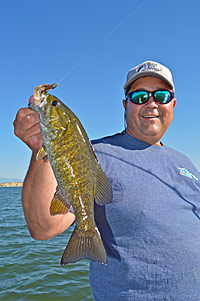
Fortunately, anglers have a lot of options when it comes to crayfish and crankbaits. Some classic crawdad imitations include the novel Arbogast Mud Bug and the archetypal Bomber. Recent creations include the timeless Rebel Crawfish, Luhr Jensen Kiadad, and Bomber Real Craw. The Strike King 3XD, LiveTarget HFC, and Storm Arashi Square 5 are more recent creations that modern anglers turn to when smallies are munching on crawdads. Again, regardless of the lure, it needs to be bumping bottom to interest bronzebacks chasing crayfish. Colors run the gambit from bright red and dark olive while sporting detailed, realistic color patterns.
The original soft bait crayfish imitation must be Uncle Josh Pork Chunk. Its shape simulated the pinchers of a retreating crayfish and was the standard as a jig trailer for decades. Today with the explosion of soft plastics, there are more crawdad imitations than you can shake a stick at. Major manufacturers like Berkley, Strike King, and others offer multiple shapes and configurations of scent-enhanced crayfish baits. Many of their roots can be traced back to the original Sweet Beaver design, but with added pinchers, appendages and details.
Crayfish imitations for smallmouths tend to be the most detailed because they have an excellent chance to check the bait out before committing or not in the clear waters that smallmouths frequent. Smallmouth lures use smaller, lifelike craws, like Z Man’s CrusteaZ, better suited for rigging on a shaky head jig, drop-shot, or split shot. Some of my favorite smallie craws include NetBait’s Paca Slim, and its slender profile, the ZOOM Bait Company’s Ultravibe Speed Craw, which is hollow and can accommodate a tube jig hook inside and Lake Fork’s Craw with its realistic appendages and tubular body. There are dozens of other soft plastic convincing crawdad imitations to choose from.
“Traditionally, crayfish concentrate big fish,” offered Joe Balog. “When you find a situation like that, it’s pretty hard to beat soft plastics whether it be a detailed, realistic craw pattern or just a tube. There was a time on the Great Lakes when about all smallmouths ate were crayfish. Now you’ve got gobies, an abundance of native darters and sculpins, and an explosion in the minnow population, but it’s still hard to find a smallie that will turn down a crayfish.”
Balog said his go-to crawdad imitation is a Zoom Speed Craw. “The Speed Craw is just a phenomenal bait,” said Balog. “Fish it on a football, Arkie-style jig. It’s ideal for casting and has a light-wire hook that’s strong enough to land the toughest smallmouth but comes loose when you get snagged.”
If you’re headed to any of the country’s top smallmouth waters, better prepare with a good assortment of crawdad imitating lures.
BassResource may receive a portion of revenues if you make a purchase using a link above.


